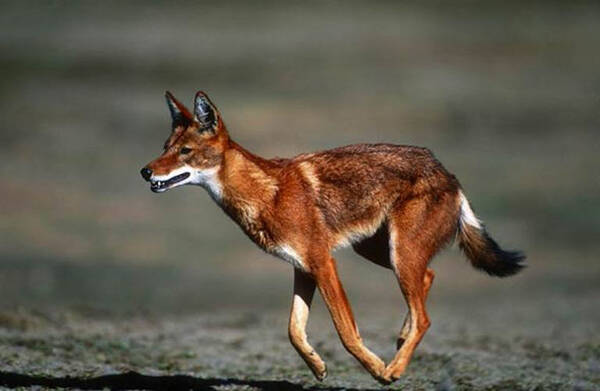Canis simensis
IUCN
LCBasic Information
Scientific classification
- name:Canis simensis
- Scientific Name:Simian jackal, steppe jackal, Abyssinian jackal, Simian mountain jackal
- Outline:Carnivora
- Family:Canis simensis
Vital signs
- length:84-101cm
- Weight:11-19kg
- lifetime:8-9Year
Feature
Distinctive reddish brown fur
Distribution and Habitat
The Ethiopian wolf is found in the high mountains of Africa at altitudes above 3,000 meters. The largest population is located in the Bale Mountains in southern Ethiopia, with others in the Semien Mountains and other areas in the north.
Inhabits the high mountains of Ethiopia. This animal lives only in a few very narrow areas in Ethiopia, with only seven isolated populations known to occupy the habitat. Lives in alpine grasslands and mountains with relatively low vegetation, generally not exceeding 25 cm, at altitudes between 3,000-4,377 meters.
Appearance
The Ethiopian wolf looks like a coyote. It is a small dog with a slender body. Males range in length from 928-1012 mm (average 963 mm), females from 841-960 mm (average 919 mm). Males weigh 14.2-19.3 kg (average 16.2 kg), females from 11.2-14.2 kg (average 12.8 kg). Tail length ranges from 270-396 mm. Males are about 20% longer than females. The skull is flat and the skull cap is cylindrical. The coronal ridge is straight and the interoccipital bone is slightly prominent. The ears are wide and pointed, and the teeth are small and sparse, which is suitable for their diet of large amounts of rodents. The tooth formula is 3/3-1/1-4/4-2/3, sometimes without the molars, and occasionally without the lower third of the molars. The canine teeth are sharp and average 19 mm long. The ears are pointed and wide, and the earlobes are very thick. The front limbs have 5 toes and the hind limbs have 4 toes.
The Ethiopian wolf is a close relative of the gray wolf and the coyote. The fur is a distinc
Details
The Ethiopian Wolf (scientific name: Canis simensis) is a small dog with two subspecies.

Every morning, Ethiopian wolf packs spend several minutes performing a greeting ritual, sniffing, barking, biting, scratching, licking, and staring at each other. This daily ritual strengthens the unity of the wolf pack and helps maintain the hierarchy of the tribe. The wolves then set out to patrol their territory. The way they mark their territory is to urinate on rocks or bushes strategically.
Ethiopian wolves are social animals, with each pack consisting of 3-13 wolves. Pack members gather at noon and dawn to patrol the territory, and most members forage alone at other times. The hierarchy is strict, but males can rise in status through fighting, which is almost impossible for females. This hierarchy is established through games when they are still young wolves. The territory ranges from 4-15 square kilometers, and small territorial conflicts between neighbors often occur. They can communicate long distances by howling.
Ethiopian wolves are carnivores and generally prey on various rats in large quantities. They also eat bird eggs and small birds, and they have the habit of digging pits to bury excess food. They are also willing to accept carrion. They usually slowly lurk close to their prey, and then suddenly jump up and take it down. Ethiopian wolves can cooperate in hunting small gazelles, lambs and rabbits. They are more closely related to wolves and coyotes than to jackals, and may have evolved from the ancestors of wolves entering Africa.
Due to the narrow living area of Ethiopian wolves, the competition for survival is relatively fierce. There is only one breeding pair of wolves in the group with a territory. The homeless wandering between territories often mate, but because there is no territory to provide them with a source of food, it is difficult for the cubs born in this situation to survive. Female wolves with low status in the group will take the initiative to help the leader take care of the newborns and even feed them.
Every year between October and January of the following year, the female leaders of each Ethiopian wolf group give birth to a litter of 2-6 cubs in a naturally formed or excavated cave. The gestation period is about 60-62 days. Newborns have closed eyes and no teeth, and their fur is charcoal grey with a light yellow spot on their chest. At 3 weeks old, they gradually change to the same fur as adults and leave the den. After this, the alpha female usually moves to a new home, moving more than 1 km away. Pups are completely dependent on breast milk from 1 to 4 weeks old, supplemented with some solid food from 5 to 10 weeks old, and from 10 weeks to 6 months old, they rely entirely on solid food provided by pack members. They reach sexual maturity at 2 years old, and their lifespan in the wild is estimated to be 8-9 years.
As of 2008, the total population of Ethiopian wolves is thought to be as low as 500, with approximately 250 breeding individuals. Only 7 packs remain, with the largest population of 120-160 individuals living in Bale Mountains National Park. The World Wildlife Fund warns that the Ethiopian wolf is in danger of extinction due to rabies. The Ethiopian wolf is one of the rarest canines. It is not only rabies that threatens the extinction of the Ethiopian wolf, but also human activities. The World Wildlife Fund said that illegal settlers have recently flooded into the national park. They destroyed the natural environment where the Ethiopian wolf lives, and these people killed the Ethiopian wolf because they thought the wolf pack was a danger to them. Domestic dogs also pose a threat to the extinction of rare animals. Because domestic dogs and wolves will weaken the unique genetic structure of the Ethiopian wolf after breeding.
Listed in the 2011 Red List of Endangered Species of the World Conservation Union (IUCN) ver 3.1 - Endangered (EN).
Protect wild animals and stop eating game.
Maintaining ecological balance is everyone's responsibility!








